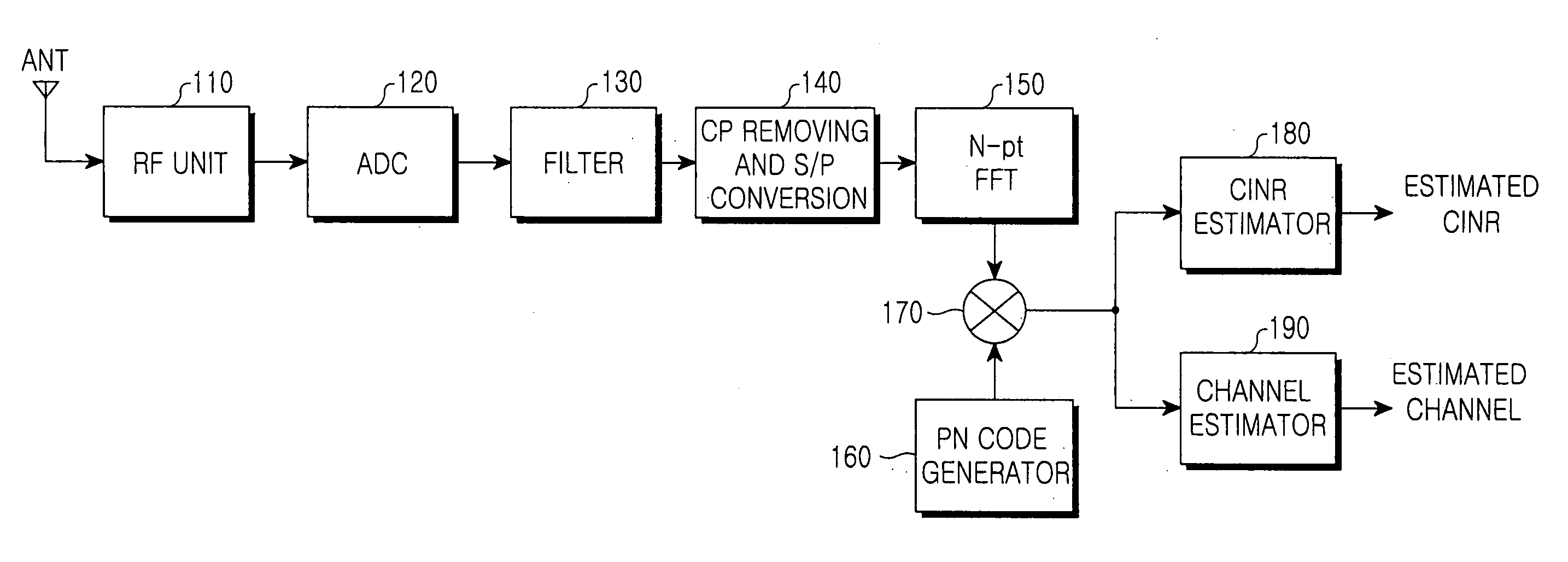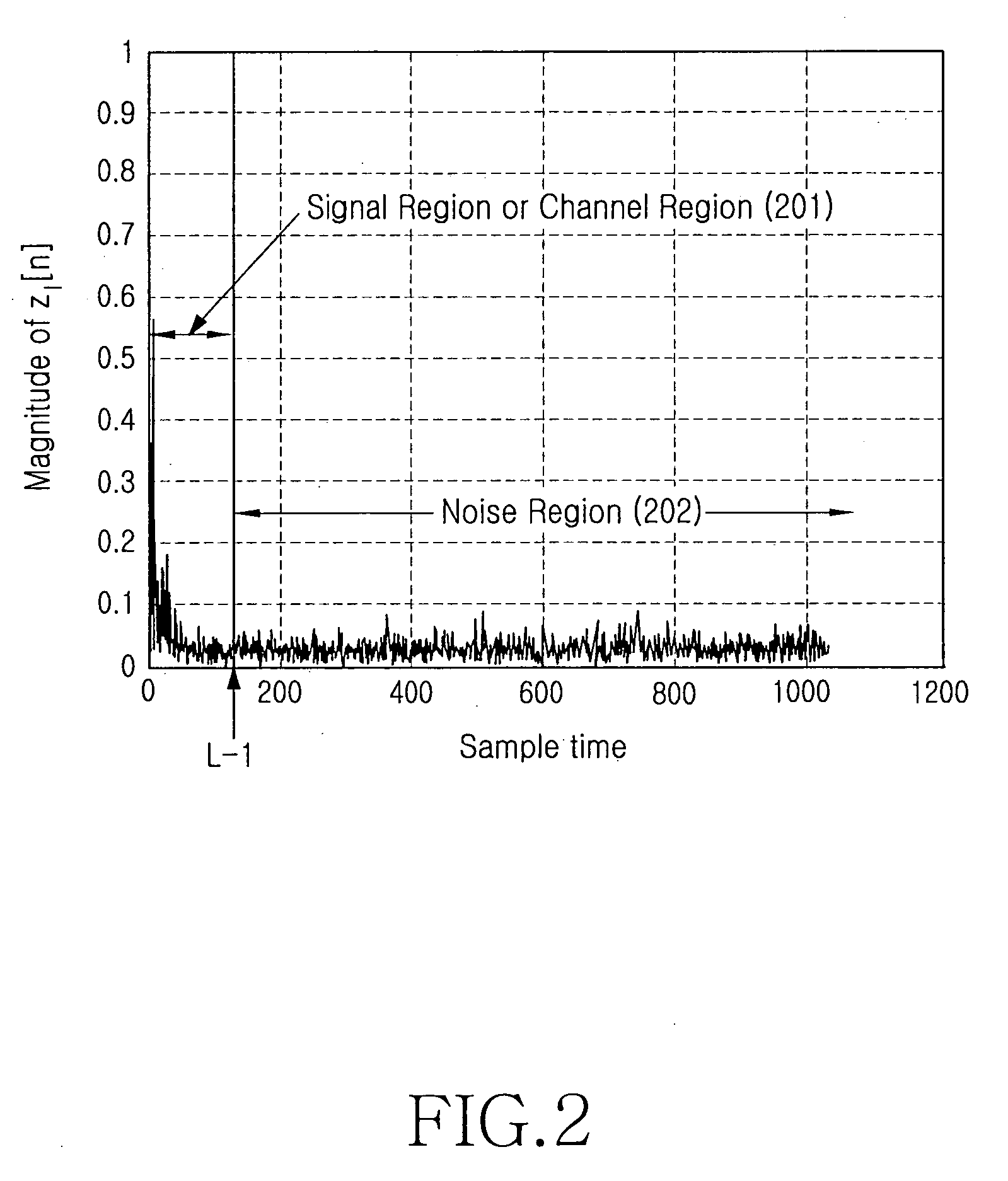Apparatus and method for estimating CINR in an OFDM communication system
a communication system and approximation method technology, applied in the field of approximation and method of estimating a cinr in a communication system, can solve the problems of increasing the estimation performance of cinr, deteriorating performance, and reaching the limit of the cdma cellular mobile communication system in providing the higher-speed data service, so as to improve system performance, accurate estimating, and increase transmission efficiency
- Summary
- Abstract
- Description
- Claims
- Application Information
AI Technical Summary
Benefits of technology
Problems solved by technology
Method used
Image
Examples
first exemplary embodiment
[0053] A time-domain signal of Equation (8) below is obtained by performing N-point Inverse Discrete Fourier Transform (IDFT), in other words, IFFT, on z1(k) of Equation (4).
zl[n]=hl[n]+il[n]+wl[n] (8)
[0054] Because IFFT preserves signal power, hl[n] is signal power, and power of il[n]+wl[n] is interference and noise power Il. In this case, using the IFFT-processed signal of Equation (8), a CINR can be calculated by CINRl=∑n=oN-1hl[n]2∑n=oN-1il[n]+wl[n]2(9)
[0055] However, because the OFDM communication system is generally designed such that a channel length L is considerably less than the number N of sub-carriers (Lzl[n]={hl[n]+il[n]+wl[n]for n=0,1,… ,L-1il[n]+wl[n]for n=L,L+1,… ,N-1(10)
[0056] In Equation (10), because a ratio of the channel length L to the number N of sub-carriers is set to a very small value of, for example, ⅛ or 1 / 16, the signal mainly includes a signal (or carrier) component in a region n=[0,L−1], and includes no signal component in a region...
second exemplary embodiment
[0072] Generally, the OFDM communication system allocates a partial region in sub-carriers as a guard sub-carrier (guard band) and transmits ‘0’, taking interference from neighbor channels into consideration. A signal wave obtained when a signal with the guard band is transmitted is shown in FIG. 5, and a signal wave obtained when a signal with the guard band is received at the apparatus of FIG. 1 is shown in FIG. 6.
[0073] When the received signal with the guard band intactly undergoes IFFT in the method of the first exemplary embodiment, there is no clear difference between the signal component and the noise component as shown in FIG. 6. In addition, when noise power is measured in the method of the first exemplary embodiment, the signal component dispersed as shown in FIG. 6 is added to the original interference and noise power, resulting in overestimation of the noises. As a result, the final estimated CINR has a bias.
[0074] When the CINR estimator is implemented through an est...
third exemplary embodiment
[0082] Although the second exemplary embodiment provides an estimated CINR whose bias is removed in the full CINR region, it may require higher hardware complexity in actual implementation. A third exemplary embodiment proposes an effective CINR estimator that finds the point where a matrix AT occurring due to the dispersion is expressed as an L×L-dimension Hermitian Toeplitz matrix, and uses FFT instead of an inverse matrix of the Toeplitz matrix. The Toeplitz matrix has the same diagonal matrix elements, and an example thereof is shown in Equation (15) below. [a0a1a2a-1a0a1a-2a-1a0](15)
[0083] The Toeplitz matrix AT can be approximated as a circulant matrix Ac. In the circulant matrix, elements of each row are sequentially represented as cyclic shifts of the first row, and an example thereof is shown in Equation (16) below. [a0a1a1a2a0a1a1a1a0](16)
[0084] The circulant matrix can undergo eigenvalue decomposition through IFFT and FFT. According to the eigenvalue decomposition theor...
PUM
 Login to View More
Login to View More Abstract
Description
Claims
Application Information
 Login to View More
Login to View More - R&D
- Intellectual Property
- Life Sciences
- Materials
- Tech Scout
- Unparalleled Data Quality
- Higher Quality Content
- 60% Fewer Hallucinations
Browse by: Latest US Patents, China's latest patents, Technical Efficacy Thesaurus, Application Domain, Technology Topic, Popular Technical Reports.
© 2025 PatSnap. All rights reserved.Legal|Privacy policy|Modern Slavery Act Transparency Statement|Sitemap|About US| Contact US: help@patsnap.com



